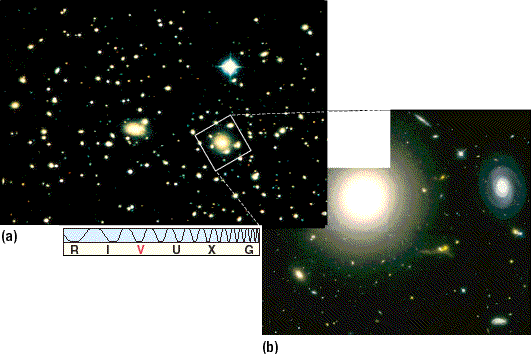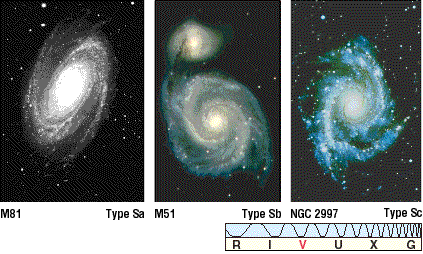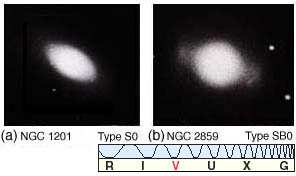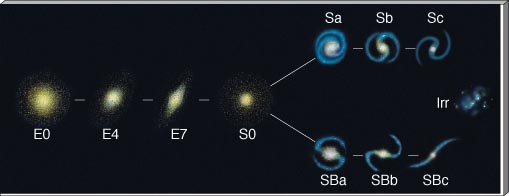Figure 24.1 shows a vast expanse of space lying about 100 million pc from Earth. Almost every patch or point of light in this figure is a separate galaxy—several hundred can be seen in just this one photograph. Over the years, astronomers have accumulated similar images of many millions of galaxies. We begin our study of these enormous accumulations of matter simply by considering their appearance on the sky.

Figure 24.1 (a) A collection of many galaxies, each consisting of hundreds of billions of stars. Called the Coma Cluster, this group of galaxies lies more than 100 million pc from Earth. (The blue spiked object at top right is a nearby star; virtually every other object visible is a galaxy.) (b) A recent Hubble image of part of the cluster.
Seen through even a small telescope, images of galaxies look distinctly nonstellar. They have fuzzy edges, and many are quite elongated—not at all like the sharp, pointlike images normally associated with stars. Although it is difficult to tell from the photograph, some of the blobs of light in Figure 24.1 are actually spiral galaxies like the Milky Way Galaxy and Andromeda. Others, however, are definitely not spirals—no disks or spiral arms can be seen. Even when we take into account their different orientations in space, galaxies do not all look the same.
The American astronomer Edwin Hubble was the first to categorize galaxies in a comprehensive way. Working with the then recently completed 2.5-m optical telescope on Mount Wilson in California in 1924, he classified the galaxies he saw into four basic types—spirals, barred spirals, ellipticals, and irregulars—solely on the basis of appearance. Many modifications and refinements have been incorporated over the years, but the basic Hubble classification scheme is still widely used today.
We saw several examples of spiral galaxies in Chapter 23—for example, our own Milky Way Galaxy and our neighbor Andromeda. All galaxies of this type contain a flattened galactic disk in which spiral arms are found, a central galactic bulge, and an extended halo of faint, old stars. (Sec. 23.3) The stellar density (that is, the number of stars per unit volume) is greatest in the galactic nucleus, at the center of the bulge. However, within this general description, spiral galaxies exhibit a wide variety of shapes, as illustrated in Figure 24.2.

Figure 24.2 Variation in shape among spiral galaxies. As we progress from type Sa to Sb to Sc, the bulges become smaller while the spiral arms tend to become less tightly wound.
In Hubble's scheme, a spiral galaxy is denoted by the letter S and classified as type "a," "b," or "c" according to the size of its central bulge—Type Sa galaxies having the largest bulges, Type Sc the smallest. The size of the bulge is quite well correlated with the tightness of the spiral pattern (although the correspondence is not perfect). Type Sa spiral galaxies, with large central bulges, tend to have tightly wrapped, almost circular, spiral arms. Type Sb galaxies, with smaller bulges, typically have more open spiral arms. Type Sc spirals, with the smallest bulges, often have loose, poorly defined spiral structure. The arms also tend to become more "knotty," or clumped, in appearance as the spiral pattern becomes more open.
Much of our description of the large-scale structure of the Milky Way Galaxy in Chapter 23 applies to spiral galaxies in general. The bulges and halos of spiral galaxies contain large numbers of reddish old stars and globular clusters, similar to those observed in our own Galaxy and in Andromeda. Most of the light from spirals, however, comes from A- through G-type stars in the disk, giving these galaxies an overall whitish glow. The spiral arms appear bluish because of the presence of bright blue O and B stars there. We assume that thick disks exist, too, but their faintness makes this assumption hard to confirm—the thick disk in the Milky Way contributes only a percent or so of our Galaxy's total light. (Sec. 23.3)
Like the disk of the Milky Way, the flat galactic disks of typical spiral galaxies are rich in gas and dust. The 21-cm radio radiation emitted by spirals betrays the presence of interstellar gas, and detailed photographs clearly show obscuring dust in many systems. Stars are forming within the spiral arms, where the interstellar medium is densest, and the arms contain numerous emission nebulae and newly formed O and B stars, as discussed in Chapter 23. (Sec. 23.5) Type Sc galaxies contain the most interstellar gas and dust, Sa galaxies the least. The Sc galaxy NGC 2997 shown in Figure 24.2(c) clearly shows the preponderance of interstellar gas, dust, and young blue stars tracing the spiral pattern. Spirals are not necessarily young galaxies, however. Like our own Galaxy, they are simply rich enough in interstellar gas to provide for continued stellar birth.
Most spirals are not seen face-on as in Figure 24.2. Many are tilted with respect to our line of sight, making their spiral structure hard to discern, However, we do not need to see spiral arms to classify a galaxy as a spiral. The presence of the disk, with its gas, dust, and newborn stars, is sufficient. For example, the galaxy shown in Figure 24.3 is classified as a spiral because of the clear line of obscuring dust seen along its midplane.

Figure 24.3 The Sombrero Galaxy, a spiral system seen edge-on. Officially cataloged as M104, this galaxy has a dark band composed of interstellar gas and dust. The large size of this galaxy's central bulge marks it as type Sa, even though its spiral arms cannot be seen.
A variation of the spiral category in Hubble's classification scheme is the barred-spiral galaxy. The barred spirals differ from ordinary spirals mainly by the presence of an elongated "bar" of stellar and interstellar matter passing through the center and extending beyond the bulge, into the disk. The spiral arms project from near the ends of the bar rather than from the bulge (as they do in normal spirals). Barred spirals are designated by the letters SB and are subdivided, like the ordinary spirals, into categories SBa, SBb, and SBc, depending on the size of the bulge. Again like ordinary spirals, the tightness of the spiral pattern is correlated with bulge size. Figure 24.4 shows the variation among barred-spiral galaxies. In the case of the SBc category, it is often hard to tell where the bar ends and the spiral arms begin.

Figure 24.4 Variation in shape among barred-spiral galaxies. The variation from SBa to SBc is similar to that for the spirals in Figure 24.2, except that now the spiral arms begin at either end of a bar through the galactic center.
Astronomers often cannot distinguish between spirals and barred spirals, especially when a galaxy happens to be oriented with its galactic plane nearly edge-on toward Earth, as in Figure 24.3. Because of the physical and chemical similarities of spiral and barred-spiral galaxies, some researchers do not even bother to distinguish between them. Other researchers, however, regard the differences in their structures as very important, arguing that these differences suggest basic dissimilarities in the conditions that led to the formation of the galaxies eons ago. The recent findings that the bulge of our own Galaxy is elongated suggest that the Milky Way is a barred spiral, of type SBb or SBc. (Sec. 23.3)
The next major category in the Hubble scheme contains the elliptical galaxies. Unlike the spirals, ellipticals have no spiral arms and, in most cases, no flattened galactic disk—in fact, they often exhibit little internal structure of any kind. As with spirals, the stellar density increases sharply in the central nucleus. Ellipticals range in shape from highly elongated to nearly circular in appearance. Denoted by the letter E, these systems are subdivided according to how elliptical they are. The most circular are designated E0, slightly flattened systems are labeled E1, and so on, all the way to the most elongated ellipticals, of type E7 (Figure 24.5).

Figure 24.5 Variation in shape among elliptical galaxies. (a) The E1 galaxy M49 is nearly circular in appearance. (b) M84 is a slightly more elongated elliptical galaxy. It is classified as E3. Both these galaxies lack spiral structure, and neither shows evidence of interstellar matter.
There is a large range in both the size and the number of stars contained in elliptical galaxies. The largest elliptical galaxies are much larger than our own Milky Way Galaxy. These giant ellipticals can range up to a few megaparsecs across and contain trillions of stars. At the other extreme, dwarf ellipticals may be as small as 1 kpc in diameter and contain only a few million stars. The substantial observational differences between giant and dwarf ellipticals have led many astronomers to conclude that these galaxies are members of separate classes, with quite different formation histories and stellar content. The dwarfs are by far the most common type of ellipticals, outnumbering their brighter counterparts by about 10 to 1. However, most of the mass that exists in the form of elliptical galaxies is contained in the larger systems.
Lack of spiral arms is not the only difference between spirals and ellipticals. Most ellipticals also contain little or no gas and dust. The 21-cm radio emission from neutral hydrogen gas is, with few exceptions, completely absent, and no obscuring dust lanes are seen. In most cases there is no evidence of young stars or of any ongoing star formation. Like the halo of our own Galaxy, ellipticals are made up mostly of old, reddish, low-mass stars. Indeed, having no disk, gas, or dust, elliptical galaxies are, in a sense, "all halo." Again as in the halo of our Galaxy, the orbits of stars in ellipticals are disordered, exhibiting little or no overall rotation; objects move in all directions, not in regular, circular paths as in our Galaxy's disk. Apparently all, or nearly all, of the interstellar gas within elliptical galaxies was swept up into stars (or out of the galaxy) long ago, before a disk had a chance to form, leaving stars in random orbits, with no loose gas and dust for the creation of future generations of stars.
Some giant ellipticals are exceptions to many of the foregoing general statements about elliptical galaxies, as they have been found to contain disks of gas and dust in which stars are forming. Astronomers speculate that these galaxies may really be otherwise "normal" ellipticals that have collided and merged with a companion spiral system (although this explanation is not yet universally accepted). We will return later in this chapter to the important role played by galactic collisions in determining the appearance of the systems we observe today (Interlude 24-1).
Intermediate between the E7 ellipticals and the Sa spirals in the Hubble classification is a class of galaxies that show evidence of a thin disk and a flattened bulge but that contain no gas and no spiral arms. Two such objects are shown in Figure 24.6. These galaxies are known as S0 galaxies if no bar is evident and SB0 galaxies if a bar is present. They look a little like spirals whose dust and gas have been stripped away, leaving behind a stellar disk. Observations in recent years have shown that many normal elliptical galaxies have faint disks within them, like the S0 galaxies. As with the S0s, the origin of these disks is uncertain, but some researchers suspect that the S0s and ellipticals actually form a continuous sequence, along which the bulge-to-disk ratio varies smoothly.

Figure 24.6 (a) S0 galaxies contain a disk and a bulge but no interstellar gas and no spiral arms. They are in many respects intermediate between E7 ellipticals and Sa spirals in their properties. (b) SB0 galaxies are similar to S0 galaxies, except for a bar of stellar material extending beyond the central bulge.
The final galaxy class identified by Hubble is a catch-all category—irregular galaxies—so named because their visual appearance does not allow us to place them into any of the other categories just discussed. Irregulars tend to be rich in interstellar matter and young, blue stars, but they lack any regular structure, such as well-defined spiral arms or central bulges. They are divided into two subclasses—Irr I galaxies and Irr II galaxies. The Irr I galaxies often look like misshapen spirals. The much rarer Irr II galaxies, in addition to their irregular shape, have other peculiarities, often exhibiting a distinctly explosive or filamentary appearance. Figure 24.7 shows some examples of these strangely shaped galaxies. Their appearance once led astronomers to suspect that violent events had occurred within them. However, it now seems more likely that in some (but probably not all) cases we are seeing the result of a close encounter, or even a collision, between two previously "normal" systems.

Figure 24.7 Some irregular (Irr II) galaxies. (a) The oddly shaped galaxies NGC 4485 and NGC 4490 may be close to each other and interacting gravitationally. (b) The galaxy M82 seems to show an explosive appearance, although interpretations remain uncertain. (c) Many irregular galaxies are small and dim, but this one, NGC 4449, is comparable in both size and luminosity to the Milky Way Galaxy.
Irregular galaxies tend to be smaller than spirals but somewhat larger than dwarf ellipticals. They typically contain between 108 and 1010 stars. The smallest are called dwarf irregulars. As with elliptical galaxies, the dwarf type is the most common irregular. Dwarf ellipticals and dwarf irregulars occur in approximately equal numbers and together make up the vast majority of galaxies in the universe. They are often found close to a larger "parent" galaxy.
Figure 24.8 shows the Magellanic Clouds, a famous pair of Irr I galaxies that orbit the Milky Way Galaxy. They are shown to proper scale in Figure 23.15. Studies of Cepheid variables within the Clouds show them to be approximately 50 kpc from the center of our Galaxy. The Large Cloud contains about 6 billion solar masses of material and is a few kiloparsecs across. Both Magellanic Clouds contain lots of gas, dust, and blue stars (and the recent, well-documented supernova discussed in Interlude 21-2), indicating youthful activity and ongoing star formation. Both also contain many old stars and several old globular clusters, so we know that star formation has been going on there for a very long time.

Figure 24.8 The Magellanic Clouds are prominent members of the sky in the Southern Hemisphere. Named for the sixteenth-century Portuguese explorer Ferdinand Magellan, whose round-the-world expedition first brought word of these fuzzy patches of light to Europe, they are dwarf irregular (Irr I) galaxies, gravitationally bound to our own Milky Way Galaxy. They orbit our Galaxy and accompany it on its trek through the cosmos. (a) The Clouds' relationship to each other in the southern sky. Both the Small (b) and the Large Magellanic Cloud (c) have distorted, irregular shapes, although some observers claim they can discern a single spiral arm in the Large Cloud.
Over the years, radio studies have hinted at a possible bridge of hydrogen gas connecting the Milky Way to the Magellanic Clouds, but more observational research is needed to establish this link beyond doubt. It is possible that the tidal force of the Milky Way tore this stream of gas from the Clouds the last time their orbits brought them close to our Galaxy. Of course, gravity works both ways, and many researchers believe that the forces exerted by the Clouds may in turn be responsible for distorting our Galaxy, warping and thickening the outer parts of the Galactic disk. (Sec. 23.5)
Table 24.1 summarizes the basic characteristics of the various galaxy types. When he first developed his classification scheme, Hubble arranged the galaxy types into the "tuning fork" diagram shown in Figure 24.9. His aim in doing this was simply to indicate similarities in appearance among galaxies, not to suggest that any connection might exist, but some astronomers have since speculated that perhaps the diagram has deeper significance. Figure 24.9 certainly suggests an evolutionary connection of some sort among galaxy types, but does one really exist? The answer, as best we can tell, is no.
| TABLE 24.1 Basic Galaxy Properties by Type | ||||||||||||||||||||||||
|

Figure 24.9 Hubble's "tuning fork" diagram, showing his basic galaxy classification scheme. The placement of the four basic galaxy types—ellipticals, spirals, barred spirals, and irregulars—in the diagram is suggestive, but no "evolutionary track" along the sequence (in either direction) is proven.
Despite many attempts, no one has ever succeeded in explaining the observed properties of normal galaxies in evolutionary terms. Isolated normal galaxies do not evolve from one type to another. Spirals are not ellipticals with arms, nor are ellipticals spirals that have somehow lost their star-forming disks. In short, astronomers know of no parent-child relationship among normal galaxies. However, the subject of galaxy evolution is still poorly understood.